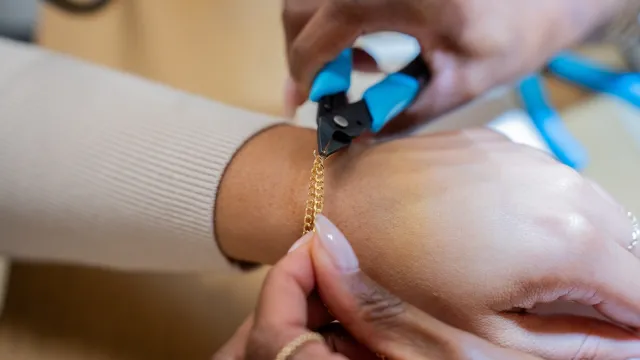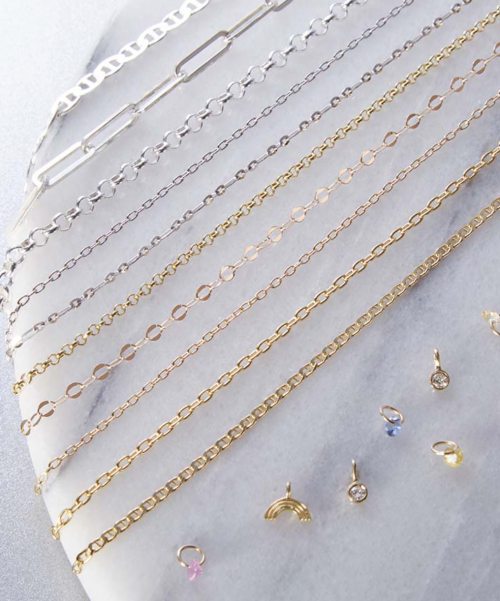What Is Permanent Jewelry and Is It Right for Me?

Tattoos and piercings have been around for centuries, but permanent jewelry is a fairly new form of lasting self-expression. If you’ve found yourself wondering, “What is permanent jewelry,” you’re not alone. According to Google Trends, searches for the term skyrocketed in the spring of 2022—and people have been interested in the topic consistently since.
Permanent jewelry started as a pop-up offering at stores like Catbird and Stone and Strand. Once the shops saw how popular it was, they added it to their core collections. The pieces also got a boost from social media sites like TikTok and Instagram, where people would post pictures and videos of their jewelry being welded on. The jewelry, which typically comes in the form of dainty bracelets, also fits in with the minimalist jewelry trends of the era.
Keep reading for everything you need to know about permanent jewelry, including who should get it, the different types that are available, how much it costs, and whether there are safety concerns.
RELATED: The Medusa Piercing: What It Means and What to Expect.
What Is the Point of Permanent Jewelry?

There are a few reasons people gravitate toward permanent jewelry, and the first is convenience. With these everyday-wear pieces, which are typically made of quality materials such as 14K gold, you don’t have to worry about tarnishing, clasps, forgetting to put them on, or losing them.
The jewelry can also have a sweet symbolic meaning. Many shoppers get them with friends, family, or partners to signify a lifelong bond or commitment. In a similar way to a ring, permanent jewelry makes a circular shape, which could symbolize eternal love. Plus, it’s “forever” if you want it to be, which is a romantic notion in its own right.
However, symbolism isn’t the only reason people love permanent jewelry. A slew of shoppers get them simply for their styling potential. Most permanent pieces come in fairly neutral designs that you can easily team with other jewelry, depending on the location of the item. If it’s on your wrist, you can stack it with a watch or chunky bracelet. And if it’s on your finger, neck, or ankle, you can stack it with other rings, necklaces, or anklets.
Even if you decide to switch your jewelry aesthetic to showcase bigger and bolder pieces, these dainty chains can easily be layered underneath to add depth without detracting from the look.
How Did Permanent Jewelry Come to Be?
One of the earliest uses of permanent jewelry may have come from ancient Egyptians. Many Egyptians at the time (around 1065 to 945 BCE) wore jewelry, and almost all of them were buried in it, according to the American Research Center in Egypt. The pieces were viewed as a form of protection and adornment that could follow their wearer into the afterlife.
One of the first forms of permanent jewelry in modern times is the Cartier Love bracelet, which was created by Aldo Cipullo in 1969. The permanent bracelet is locked onto the wearer’s wrist using a special screwdriver and requires a second set of hands to take on and off, making it “permanent” but still giving wearers an out.
At the time of its invention, the Love bracelet was unique in its versatility—it was a piece that could, and almost had to be, worn day and night and for all sorts of occasions, at a time in history when jewelry was typically either formal or informal. It set the stage for other permanent pieces that were also versatile enough to be worn all day, every day.
The Brooklyn, New York-based jewelry company Catbird launched the current permanent jewelry craze. It began making its Forever Bracelets in 2017, and cleverly dubbed the actual welding process “getting zapped.” By the time these dainty bracelets hit the scene, minimalist jewelry was the “it” item, and many of the store’s permanent options still lean that way. However, there are a few welded bracelet options in thick paperclip chains, as well as ones with diamonds, gemstones, and charms.
In 2022, permanent jewelry, especially permanent bracelets, went viral on TikTok, with people posting videos of their zapping appointments. More jewelers began creating the pieces, making them accessible to people outside of the New York area.
RELATED: The 12 Best Belt Bags for Women, Stylists Say.
What Are The Different Types of Permanent Jewelry?

- Permanent Bracelets: According to Google Trends data, this is the most popular form of permanent jewelry. Many permanent bracelets are made of thin, delicate chains, but there are also options for thicker chains and ones with jewels or charms.
- Permanent Anklets: This is a great option, especially if you spend lots of time in sandals or heels since it adds pizazz to the lower leg area. However, not all shops will create them.
- Permanent Necklaces: If you never take off your go-to necklace, consider having it permanently welded on, which means you’ll never have to worry about a migrated clasp again. Note that not all shops offer these, either.
- Permanent Rings: Permanent rings use the same jump-ring mechanism as welded bracelets, but they’re located on your finger instead. Because of the nature of a ring, you may be able to slide it on and off regardless; however, it’ll be made of a chain material versus solid metal.
How Much Does Permanent Jewelry Cost?
The price of your permanent jewelry pieces will depend on the city and store you get them at, any gems you add, and the piece’s placement (for example, since a ring uses less chain than an anklet or necklace, it’ll cost less than those items made from the same material).
The metal you choose will have a big impact on the price—and many stores recommend 14K gold. “It’s durable, tarnish-proof, and hypoallergenic, making it a great lifetime investment,” says Joosep Seitam, co-founder of the jewelry e-commerce website Icecartel. He notes that 14k gold filled, sterling silver, titanium, and stainless steel could work, though you’d need to make an effort to keep them polished and scratch-free. 14K solid gold will be the most expensive, and stainless steel would be the least.
At Catbird, forever bracelets start at $108 (the store only works in 14K gold) and go up to $248. You could then add a charm for as little as $34 for a disco ball or $118 for a diamond. At Stone and Strand, the chains start at $50 for sterling silver and go up to $120 for a solid gold chain. The zapping service is included in the price of the chain and doesn’t cost extra.
Is Permanent Jewelry Safe?

For most people, yes—permanent jewelry is safe.
Although getting “zapped” might sound scary—and like there could be some pinching involved—the process is completely painless. The “zap” refers to the flash of light that occurs when the fine jewelry is welded together (and even with the flash, you’re advised to look away to protect your eyes).
The people behind the zappers are well-trained, too. “A basic training can cover things like how to set up the machine, understanding different metals, and welding techniques for bracelets, anklets, necklaces, and rings,” says Seitam.
Before getting permanent jewelry, you might also be worried about an allergic reaction. Reactions are most common with nickel, and about 18 percent of people in North America have this allergy, according to the American Academy of Dermatology (AAD). Depending on the level of your nickel allergy, you may or may not be sensitive to 14K gold, which includes some amounts of the metal (18K and 24K contain even less). Titanium and sterling silver are both nickel-free options.
If you find out about your allergy after you get your jewelry, you can simply remove it at home with a scissor. “Rashes caused by a nickel allergy are not life-threatening, but they can be uncomfortable,” writes the AAD. “The best way to avoid symptoms is to avoid objects containing nickel.”
Doctors advise against the jewelry for various reasons, including pregnancy and swelling risks. “Have you been pregnant? Was your wrist or hand or fingers or ankle the same size during that pregnancy—I don’t think so,” says Jessica Kiss, MD, (@AskDrMom) on TikTok. “Think about a catastrophic car accident when you need surgery; think about the bee sting on your wrist that swells it up—I could probably go on and on and on about why this is not a good idea.”
She advises that if you get permanent jewelry, you also get a jewelry cutter.
RELATED: The 6 Luckiest Gemstones You Can Wear, According to Experts.
Can Permanent Jewelry Be Removed?
Yes! You can cut off your jewelry with scissors, ideally at the jump ring where the two ends were welded together (that way, it can be put back on easily if you’d like). You can also make an appointment with your jeweler to have it removed. Either way, the bracelet doesn’t have to be forever if you don’t want it to be.
Are There Any Drawbacks Concerning Permanent Jewelry?
Some of the biggest concerns about permanent jewelry pieces are around removing them. “Most permanent jewelry is designed to break with little effort and can be easily removed with scissors or similar cutting tools,” says Seitam. The same is true if you experience skin sensitivity: Simply remove the chain as soon as you notice any discomfort.
Prospective buyers might also be concerned about whether or not the jewelry will tarnish over time. “High-quality materials like silver and gold are known for their resistance to corrosion, oxidation, and scratches,” says Seitam.
Because most shops stick to these materials with the intention of the pieces lasting a lifetime, wear and tear shouldn’t be an issue. However, it all depends on the materials you choose, so chat with your jeweler to ensure you’re getting something that will live up to your expectations.
Permanent jewelers often field questions about airport security, and the consensus is it’s fine. “We have traveled far and wide with our Forever Bracelets and have never had a problem,” reads the Catbird website. “Generally, delicate jewelry never needs to be removed when going through airport security.”
Forever Jewelry Brands to Know

Catbird: This shop opened in New York in 2004 and also has shops in L.A., D.C., and Boston. The in-house line is made in New York, and all the designers it carries use recycled and ethically sourced gold and diamonds.
Link x Lou: This shop exclusively offers permanent jewelry in the form of bracelets, necklaces, anklets, and rings, and has locations in Denver, Miami, Dallas, Nashville, L.A., New York, Chicago, and Kansas City.
Stone and Strand: This shop opened in 2013 and has a physical location in New York City. It specializes in everyday-wear jewelry without a markup and started its permanent jewelry line in 2020.
Love Weld: This shop began hosting permanent jewelry pop-ups in New York City in 2020 and now has locations in California, Colorado, Florida, Louisiana, D.C., New Mexico, and Texas. Welding is all they do here!
Astrid and Miyu: This New York-based shop opened in 2012 and offers welded bracelets and rings made of 9K gold and white gold.
Conclusion
The decision to get permanent jewelry ultimately depends on you, your style goals, and medical advice from your doctor or dermatologist. For more style stories, visit Best Life again soon.
- Source: AAD: Nickel Allergy